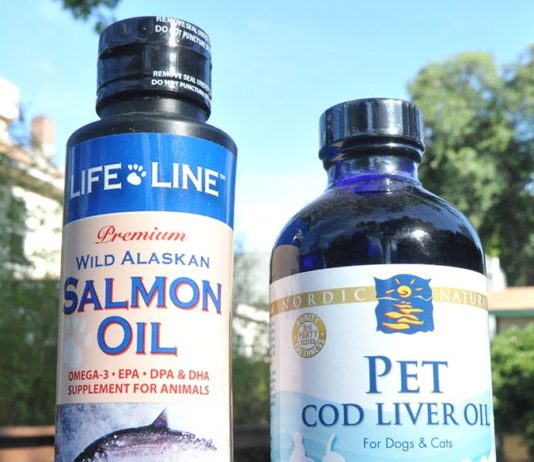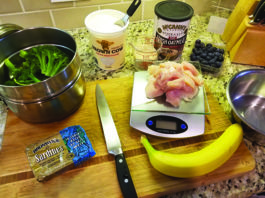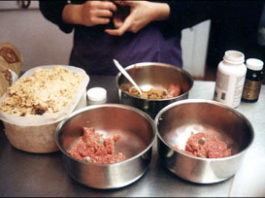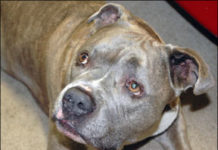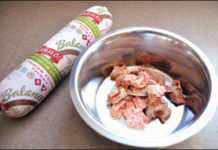Dishing On Diets
Four veterinarians from the School of Veterinary Medicine at the University of California, Davis, published a study in the June issue of the Journal of the American Veterinary Medical Association, entitled “Evaluation of recipes of home-prepared maintenance diets for dogs.” I don’t think any WDJ readers will be surprised to hear that their findings were not exactly positive. The study analyzed 200 recipes. Of those, 133 were obtained from 2 veterinary textbooks and 9 pet care books (two of which were also written by veterinarians), and the remaining 67 recipes came from 23 different websites. Of all the recipes analyzed, 129 were written by veterinarians, and 71 by nonvets.
Raw Meat-Based Dog Food Diets
There are some very high-profile illnesses that can result from handling raw meat – scarifying things like E. coli, salmonella, and trichinella. The mere idea of these threats prevents many people interested in “raw feeding” from giving this type of highly beneficial diet a try. So, we’re going to demystify everything that could go wrong with raw meat (but probably won’t). We’ll describe some horrible diseases, and how they would affect a person who got them, and how they would affect a dog.
High Pressure Processing in Raw Dog Food
Were you aware that, according to Federal law, it's okay for a certain percentage of the chicken you buy in the supermarket to contain some Salmonella bacteria? The legally acceptable amount depends on the kind of chicken we're talking about; if we're talking about whole raw broiler chickens, up to 9.8 percent could be infected, but if we're considering raw chicken parts, the number is even higher. In fact, up to 15.4 percent of the raw chicken parts may contain that pathogenic bacteria, without setting off any sort of recall or hysteria. In contrast, even a single positive test for Salmonella in raw dog food triggers a recall and headlines and a certain amount of hysteria among dog owners. What gives?
When Feeding a Raw Diet Use Safe Meat Handling Practices
One of the greatest concerns many people have about switching their dogs to a raw diet is the fear of bacterial infection, either in themselves or their pets. News reports of people dying from E. coli and salmonella poisoning have no doubt fanned the flames of that fear. But most people who have successfully transitioned their dogs to a raw diet report no problems are delighted with their dogs’ health and appearance. The secret, advocates say, is in good food handling practices. Dog owners who neglect safe handling techniques are certainly more at risk of infection from any pathogens (a list of the usual suspects is discussed in great detail in “What Evil Lurks Within,” page 9) that happen to be present in raw meat. This is especially true of children, whose immune systems are immature and inexperienced, and people with compromised immune systems. But keeping your meat safe and your kitchen clean is not exactly rocket science, folks! Anyone can learn to do it.
Raw Dog Food Diet Recipes
Feeding a raw dog food diet to your dog is quite simple, especially once you have a system in place. Though like anything else new, it can seem very complicated when first starting out. These sample dog food diets should be helpful to dog caretakers who are considering feeding a raw diet. Even those who have been doing it for a while may learn some new tricks to make the process of finding, preparing, and storing home prepared dog food simpler.
Green Tripe for Dogs
Voss kept her dogs supplied with fresh tripe
The State of the Commercial Raw Diet Industry
Three of the most knowledgeable and experienced advocates of well-formulated raw diets for dogs have joined forces to explain how to evaluate commercial raw diets. We described them in the inaugural installment of this column last month: Dr. Karen Becker, a leading holistic veterinarian; Steve Brown, one of the founders of this industry; and Mary Straus, one of the most dedicated canine nutrition researchers and writers. This month, we've asked them to address the state of the commercial raw diet industry, starting with diets that are labeled as complete and balanced" or "AAFCO-compliant" (formulated to meet the nutritional levels established by the Association of American Feed Control Officials).Their executive summary? More and more dog owners and veterinarians are learning that well-formulated raw diets are the best food for most dogs most of the time but the commercial raw dog food industry has problems. They are disappointed with the apparent lack of basic nutritional knowledge demonstrated by many companies as evidenced by the formulation of their products despite the manufacturers' good intentions.They hasten to add
Home-Prepared Pet Food Diets
Those of us who feed our dogs a raw diet that includes bones believe that this is the healthiest, most natural diet dogs can eat. But not everyone is comfortable feeding such a diet to their dogs. Here are directions for feeding your dog a cooked diet, or a diet that includes raw meat but no bones. Your dog will still benefit from a variety of fresh foods in proper proportions, regardless of how theyfre prepared. It takes a little more work to ensure that a cooked diet that does not include bone meets all of your dogfs nutritional needs. Wefll explain how much calcium, and in which form, youfll need to add to his diet.
Celebrate with These Thanksgiving Recipes for Dogs!
Thanksgiving is a time when families gather together to enjoy good food and to remember all the things we have to be grateful for. Unfortunately, one part of our family often gets left out our dogs! It must be frustrating for them to smell all the wonderful aromas coming from the kitchen, but not be able to share in the feast. We're here to relieve that vexing situation with recipes for some healthy Thanksgiving dishes just for them.
Frozen Raw Meat-Based Dog Food Diets
There are thousands of dog guardians who feed their dogs homemade BARF-based diets, buying all the ingredients and preparing their dogs’ meals from scratch. People who utilize home-prepared diets are happy to discuss the many benefits of this feeding method for their dogs, including clean, tartar-free teeth; fresh breath; strong bones, muscles, and joints; a glossy coat; a healthy amount of energy and a balanced temperament; and overall vibrant good health. For all the people who have made the leap to a homemade, meat-based diet for their dogs, however, there are many more who would like to make the change, but who are intimidated by the challenge of “getting it just right.” Some are afraid of failing to present their dogs with a balanced array of nutrients; others fear bacterial contamination from handling raw meats.
Whole Dog Journal’s Commercial Frozen Raw Dog Food Review
The more I've learned about the meat used in pet food, the more I've come to admire commercially produced frozen raw diets for dogs. The meat and poultry used in most of these diets are far fresher and more wholesome - far more like what most of us would think of as "meat" - than most animal protein ingredients in dry (or even canned) pet foods. The products tend to produce terrific results in the dogs who consume them. Whether this is due to the ingredient quality or the fact that this type of diet is more biologically appropriate for canines than dry foods is anyone's guess. My guess is that both factors contribute to the success of the products.
Shopping for Nutritional Supplements For Your Dog
Every two weeks I faithfully fill the pill organizers for my Boxer, Tyler. He receives a number of supplements, some for general nutrition and well-being, and some specific to his particular health challenges, including Addison’s disease. I’m not the only one performing this ritual. According to the American Pet Products Manufacturers Association, about nine percent of all dogs receive vitamins regularly; perhaps an even greater percentage of WDJ readers give supplements to their canine companions.


